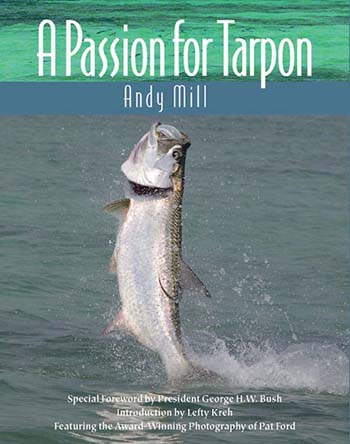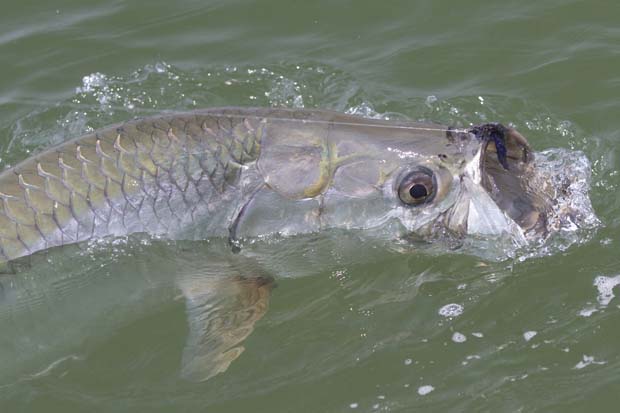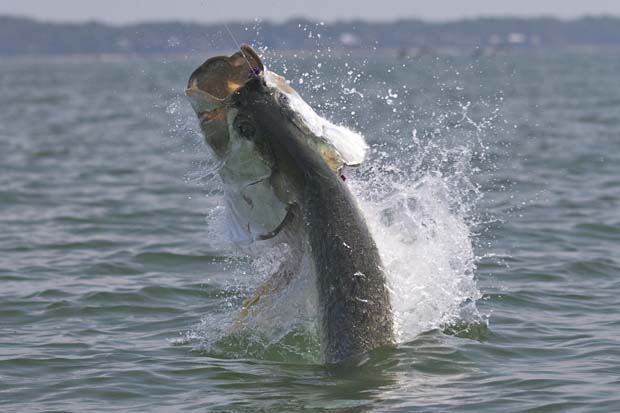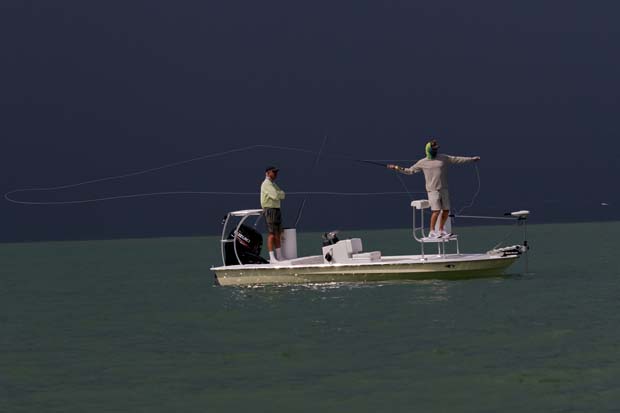NOTE: All tarpon images by Capt. Greg Dini. Intro by FLM staff. If you missed Part I, click here […]
[dropcap]I[/dropcap]n this hemisphere, it’s possible that Andy Mill knows as much about tarpon catching as anyone dead or alive – spin or fly. In this story on advanced fly fishing for tarpon, we’ll draw on his hard-earned knowledge. A knowledge that he served up to readers in his award-winning book called A Passion for Tarpon.
If you have a passion for tarpon, we can promise you that you’ll take away from this single chapter enough to make you a better tarpon angler and, especially so, if you’re an angler with big ‘poons on the mind.
Big female tarpon can be a fickle thing when presented with a fly. She may turn away from it, sit tight and stare at it, follow it right up to the boat or absolutely massacre it and put on the show of a lifetime. Making the latter happen is a combination of luck, choosing a fly of interest, great casting, having the fly in the right water column, correctly setting the hook, fighting the fish properly, landing it as quickly as possible and making a safe in-water release. The devil, however, is in the details of doing – so let’s examine how Andy gets there.
Part Two ~ Feeding the Animal

Andy Mill’s book won several awards. Looking for the perfect Father’s Day gift? To order click here
By Andy Mill
Yes, I do believe on a bright day the ’poon will eat flies better than bait. My personal best is feeding 17 fish, jumping 13 and taking the fly out of 10 fish in one day. That was in 2008. They were pretty sophisticated fish and five were more than 100 pounds. I know others who have done as well or better because of the tarpon’s willingness to smash feathers and fibers dangled in their face. I am convinced that during daylight hours the right fly for the moment, presented properly and fed to the tarpon, is the most deadly and effective bait you can use. During daylight competent fly fishers out-fish the bait guys all the time.
Still, at times using the correct techniques, flies and leaders won’t get the job done. But if you remember the kitten-and-string concept and learn how to force-feed this fish you too will catch more and bigger tarpon.
I’ve always thought that a good angler can catch fish, a lot of fish and big fish. But a great angler can do not only that-he or she can catch the fish that doesn’t want to be caught. That is the difference between good angling and great angling.
Fish in general fall into a number of categories in so far as how demanding they are in getting them to eat your fly-from an ultra-sensitive 16-inch brown trout sipping mayfly spinners to the mindless crash of a 30-pound jack or a 75-pound spinner shark destroying a popper.
How wonderful is this fish?
Somewhere in the middle is the wonderful art of communicating with a dinosaur called Megalops atlanticus. How wonderful is this fish? A tarpon can grow to a weight in excess of 300 pounds. It’s a fish that swims in clear, shallow water, and loves to eat flies, and once hooked catapults through the air with a wildness that leaves the angler awestruck. The flight of a big tarpon is spellbinding, chilling, paralyzing, and more often than not really messes with the weak-kneed. For me, though, the most compelling characteristic of a tarpon is its ability to “speak” to us humans through its body language.

Momma’s played out and ready for a quick release. Clich here to visit Capt. Greg Dini’s website
The ’poon flexes, yawns, slides, kicks, sucks, scarfs, snatches, smashes and destroys flies, leaving you stunned: standing with your rod in your hands, an empty feeling from head to toe, and a year of sleepless nights. That’s what happened to me the first time I hooked up. All these adjectives represent the body language I’ve seen Megalops speak. Each one reveals what the fish is thinking and going to do before he does it, and while it’s doing it. Eventually you’ll understand all this if you spend enough time with the fish.
It’s critical to avoid the key mistake many inexperienced tarpon anglers initially make: mindlessly stripping the fly at a fast pace, hoping the fish will race over and eat it. That’s no way to seduce this fish. Instead, learn to dance.
When a young man first asks a young woman to dance he doesn’t race over, grab her and start an aggressive fast-paced two-step body bump. That is if he has any smarts or style.
It’s the same with trying to get a tarpon to eat your fly. Soft and gentle is the best approach. Speak with whispers and silky wine. First, get the fish to see your fly-take her hand-let the fish to slide up in perfect alignment and allow the dance to begin. Think of it as just that, a dance, where each and every move you make is determined by what the fish does in response to your previous move.
A prerequisite to this “courtship” is what we spoke about previously: a culmination of a correct reading, casting and presentation to the fish with the fly ultimately ending up in the right depth in the water column in perfect alignment with the fish.
Once the fish sees your fly and remains happy, staying in line with the fly, a soft, smooth slide should get this happy fish to move toward your bug. Remember, you want to close the gap between your fly and the fish without stopping the fly. Once the fish starts to elevate and begins to accelerate toward the fly, you know you’re about to get a grab.
The cat and the string are at play!
Keep the fly moving while continuing to allow the fish to close the gap. Small, quick bumps should close the deal. Another very important thing to remember is to try to feed the fish as far away from the boat as possible. If the fish gets too close, even though he wants to eat your bug, he’ll feel the boat and bolt
[information]
Editors’ NOTE: Republished with permission from Wildriver Press: This article, Feeding the Animal, has been excerpted from A Passion for Tarpon by Andy Mill.
NOTE: Wild River Press reports that they are nearing selling out of the first edition of Andy Mill’s award-winning book. You may order your copy today at or by telephoning 425-486-3638.
Contact:
Thomas R. Pero
Publisher
Wild River Press
Post Office Box 13360
Mill Creek, Washington 98082 USA
Telephone: 425-486-3638
Federal Express and UPS shipping: 2315 210th Street SE, Bothell, Washington 98021. Published with permission: Excerpt from a A Passion For Tarpon by Andy Mill. Publisher: wildriverpress.com, Mill Creek, Washington.
[/information]
.




Join the discussion One Comment